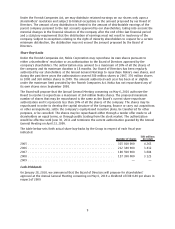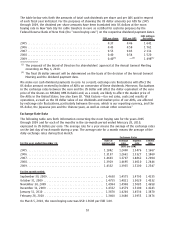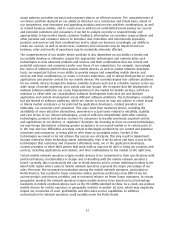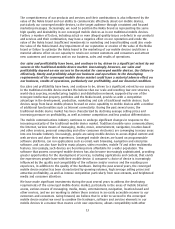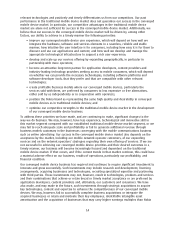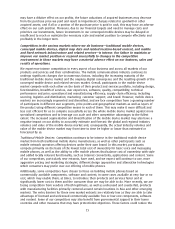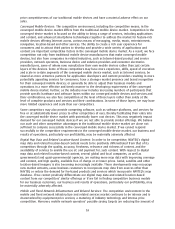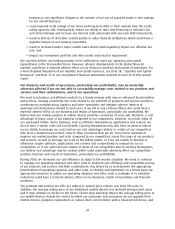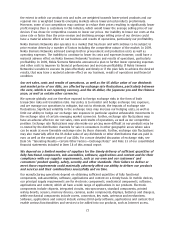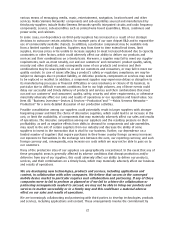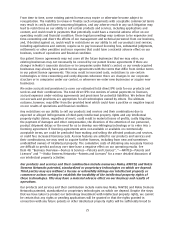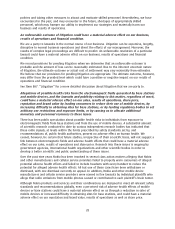Nokia 2009 Annual Report Download - page 21
Download and view the complete annual report
Please find page 21 of the 2009 Nokia annual report below. You can navigate through the pages in the report by either clicking on the pages listed below, or by using the keyword search tool below to find specific information within the annual report.ability to successfully introduce valueadded products and services, such as converged mobile devices
that drive the upgrade and replacement of devices, as well as ownership of multiple devices. NAVTEQ
is dependent on the development of a wide variety of products and services that use its data, the
availability and functionality of such products and services and the rate at which consumers and
businesses purchase those products and services. Nokia Siemens Networks is dependent on the pace
of the investments made by mobile network operators and service providers. If we and the mobile
network operators and distributors are not successful in our attempts to increase subscriber numbers,
stimulate increased usage or drive upgrade and replacement sales of mobile devices and develop and
increase demand for valueadded services, including content and applications, or if mobile network
operators and service providers invest in the related infrastructure less than anticipated, our business
and results of operations could be materially adversely affected.
As we are a global company with sales in most countries of the world, our sales and profitability are
dependent on general economic conditions globally and regionally. The traditional mobile
communications industry has matured to varying degrees in different markets and, consequently, the
industry is more vulnerable than before to the negative impacts of deteriorations in global economic
conditions. Our net sales and profitability were negatively impacted in 2009 by, among other factors,
the deteriorated global economic conditions, including weaker consumer and corporate spending,
constrained credit availability and currency market volatility. The demand environment, in particular
for mobile devices, improved during the latter part of 2009 as the global economy started to show
initial signs of recovery. However, there can be no assurances that a sustainable global recovery is
underway and about the impact and the timing of any such recovery in the various markets where
Nokia does business. Accordingly, if these initial improvements are only temporary or if there is a
continuation of, or further deterioration in, the current global economic conditions, this may result in
our current and potential customers and consumers postponing or reducing spending on our products
and services and their combinations. In addition, mobile network operators may reduce the device
subsidies that they offer to the consumers or attempt to extend the periods of contracts that obligate
the consumer to use a certain device and postpone or reduce investments in their network
infrastructure and related services. The demand for digital map information and other locationbased
content by automotive and mobile device manufacturers may decline in relation to any further
contraction of sales in the automotive and consumer electronics industry.
In addition, any further deterioration in the current global or regional economic conditions may:
• limit the availability of credit which may have a negative impact on the financial condition, and in
particular on the purchasing ability, of some of our distributors, independent retailers and network
operator customers and may also result in requests for extended payment terms, credit losses,
insolvencies, limited ability to respond to demand or diminished sales channels available to us;
• cause financial difficulties for our suppliers and collaborative partners which may result in their
failure to perform as planned and, consequently, in delays in the delivery of our products and
services, including applications and content;
• increase volatility in exchange rates which may increase the costs of our products and services
that we may not be able to pass on to our customers and result in significant competitive
benefit to certain of our competitors that incur a material part of their costs in other
currencies than we do; hamper our pricing; and increase our hedging costs and limit our
ability to hedge our exchange rate exposure;
• result in inefficiencies due to our deteriorated ability to appropriately forecast developments in
our industry and plan our operations accordingly, delayed or insufficient investments in new
market segments and failure to adjust our costs appropriately;
• cause reductions in the future valuations of our investments and assets and result in
impairment charges related to goodwill or other assets due to any significant
underperformance relative to historical or projected future results by us or any part of our
19


